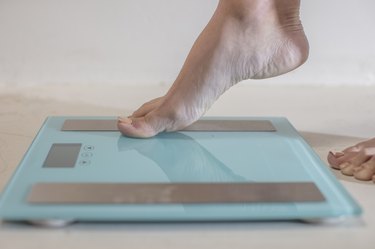
The list of serious health concerns linked to obesity is long, including heart disease, diabetes, cancer, osteoarthritis, sleep trouble and asthma. And there's another one: skin problems.
"Clinically diagnosed obesity can trigger changes in the skin," explains Connie Diekman, MEd, RD, a St. Louis-based food and nutrition consultant, former president of the American Dietetic Association and former director of university nutrition at Washington University in St. Louis.
Video of the Day
Video of the Day
"Some of these changes are due to the extra skin which can often create folds, allowing moisture to accumulate and bacteria to thrive," she says. "This is often found on the trunk of the body, since little air gets to those folds. But it can occur anywhere that skin laps over itself, creating an environment for moisture and, if not cared for, bacterial growth."
Development of Stretch Marks
One obesity-related skin issue is stretch marks. According to the U.S. National Library of Medicine (NLM), stretch marks — striae, in medical terminology — can arise when the skin is rapidly stretched.
"Not everyone gets these, and the exact mechanism for why they occur is not clear," says Diekman. "But stretch marks are the result of body fat pushing on muscles, creating the crease-like appearance." And they are in fact common, she adds, "when areas of the body gain weight quickly."
The appearance of stretch marks can vary, NLM notes. Some take the shape of irregular bands, stripes or lines, while others have the look of parallel strips of thin red skin that over time can take on a white appearance, much like a scar.
The Mayo Clinic points out that stretch marks often develop around the stomach, breasts, hip, buttocks and thigh areas. Though not particularly painful, once they appear they're unlikely to fade away completely, which means that, over time, the problem can trigger psychological distress among those who are disturbed by the impact on their appearance.
Skin Discoloration
Another possible skin issue related to obesity is a condition called acanthosis nigricans (AN). The Mayo Clinic explains that this skin problem is defined by dark velvet-like discoloration that develops slowly within the folds and creases of fat. The discoloration is often found in the armpit, groin and neck area. And affected skin can become thick, itchy and odorous over time.
While there is no specific treatment for AN, the American Academy of Dermatology says dermatologists may prescribe symptom-relieving topicals or laser therapy.
As for obesity-related risk, the Mayo Clinic notes that the heavier people are, the more likely they are to develop the condition. At the same time, "the brown or dark spots on the skin likely are from the development of insulin resistance that occurs as a result of increased body fat," says Diekman. On that front, the Mayo Clinic explains that insulin resistance is a precursor for type 2 diabetes, for which obesity is a risk factor.
Skin Infection Risk
Among obesity-related skin infections, cellulitis is a very common concern, the Mayo Clinic states. The culprit is typically streptococcus or staphylococcus bacteria, and affected areas are usually swollen, red, painful, tender and warm.
The infection can take up residence wherever a crack in the skin permits bacteria to enter, the Mayo Clinic notes. Often that's across the lower legs, but it can also spread across the face or arms. And if untreated, it can prove fatal as the infection has the potential to get into the blood stream and spread to the lymph nodes.
Beyond cellulitis, a study published in November 2019 in the Journal of the American Academy of Dermatology reports that obesity ups the risk for inflammatory skin diseases, rosacea, psoriasis and Candida (yeast) skin infections.
According to NLM, candida (cutaneous candidiasis) is a yeast infection, and one that's relatively common. But as it is apt to take hold in warm, moist and creased areas, people with obesity are particularly prone.
As for psoriasis, the Mayo Clinic explains that the condition is a chronic disease and, like rosacea, has no known cure (although there are quite a number of options for easing symptoms).
Psoriasis involves the acceleration of the skin cell life cycle and is characterized by patches of red, scaly, dry, itchy, burning and/or sore skin. Psoriasis flares can come and go, with long breaks between bouts. Obesity ups the risk for developing the disease, alongside stress, family history, a history of smoking and a compromised immune system, Mayo notes.
Read more: 10 Science-Backed Ways to Help Prevent Obesity
- Connie Diekman, MEd, RD, food and nutrition consultant, St. Louis, Missouri; former president, American Dietetic Association; author, The Everything Mediterranean Diet Book; former director, university nutrition, Washington University in St. Louis
- U.S. National Library of Medicine: "Stretch Marks"
- Mayo Clinic: "Stretch Marks"
- Mayo Clinic: "Acanthosis Nigricans"
- Mayo Clinic: "Cellulitis"
- Journal of the American Academy of Dermatology: "Skin Changes in the Obese Patient"
- NLM: "Candida Infection of the Skin"
- Mayo Clinic: "Psoriasis"
- American Academy of Dermatology: "Acanthosis Nigricans: Diagnosis and Treatment"
Is this an emergency? If you are experiencing serious medical symptoms, please see the National Library of Medicine’s list of signs you need emergency medical attention or call 911.